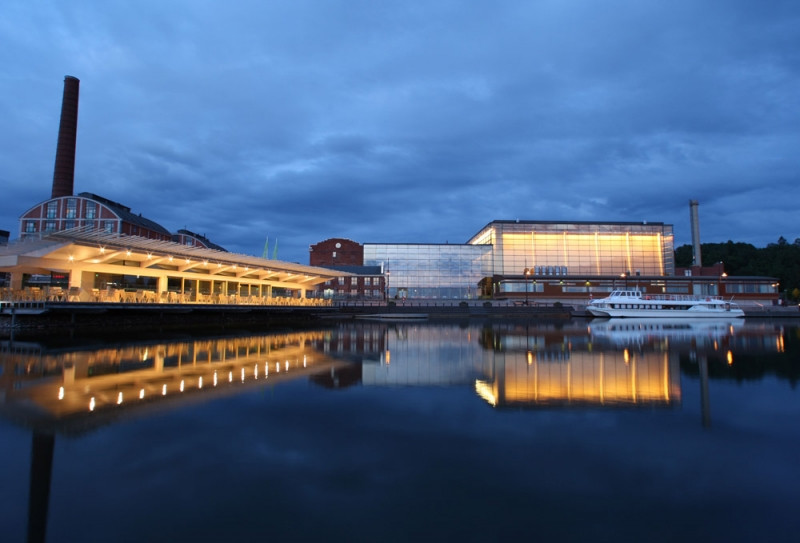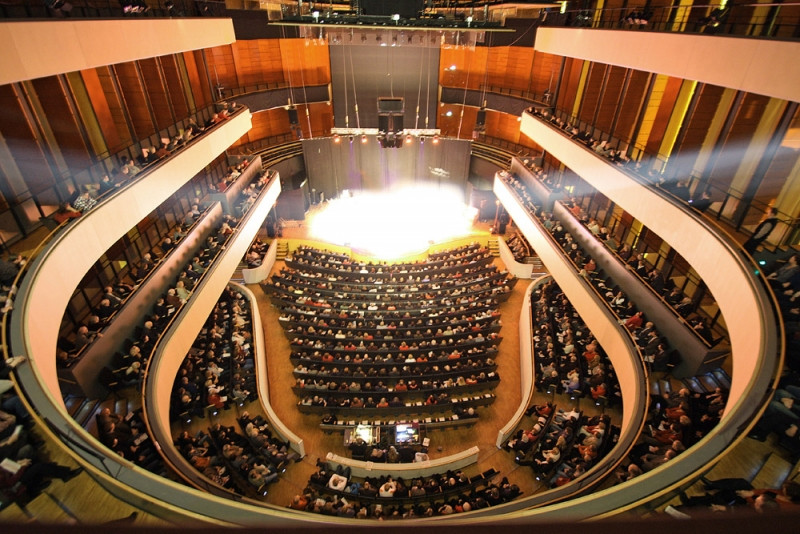The event will take place in Sibelius Hall, on the shore of the beautiful Lake Vesijärvi. The address of the Hall is Ankkurikatu 7, 15140 Lahti (Google Maps).
Getting here
It is about a 20-minute walk from the city centre of Lahti, or 6 minutes by bus (the most convenient bus is number 3). From Lahti Travel Centre (railway station), it is about 30 minutes on foot or 10 minutes by bus.
To check the bus timetable, you can either go here (choose English language) or download the Moovit app. Please note that Google Maps may not update public transport timetables in some places in Finland; use it at your own risk!
For public transport inside Lahti, how to buy bus tickets etc., see Travel Info.

About the venue
Sibelius Hall was built in 2000 adjacent to an old factory building. The modern wooden architecture is combined with the old industrial history in the most interesting way. The very spacious Forest Hall and the stunning lake scenery create an incredible atmosphere for big lunches, festivities and events. A view of Lake Vesijärvi opens from every room of the Congress Wing.
Architecture
The impressive wooden concert- and congress centre rose on the Vesijärvi waterfront in spring 2000. Its architects, Hannu Tikka and Kimmo Lintula, explained that the main source of inspiration for the design was the Finnish forests. The forest had always provided our ancestors with nourishment and raw materials, but it also involves mythical memories and scents – it has a relaxing essence. Another natural starting point in the design came from the industrial history of the site, the uncomplicated aesthetics of the old brick buildings, and the vicinity of water.
During its construction, the house was considered the flagship of wooden construction, which, when completed, was the biggest public wooden building built in Finland for over a hundred years. The Sibelius Hall complex, an area of nearly 90,000 m3, is composed of four elements: the renovated Carpenter’s Factory, the Main Hall building, Forest Hall (linking the previous elements together), and the Congress Wing (which is connected to the complex via a glass passage).

Main Hall
The famous Main Hall acts as an arena for big conferences and as a concert venue. The Main Hall is an acoustic miracle, which creates unforgettable musical memories for concert goers. The auditorium seating and stage are situated in an oval-shaped ‘shoebox’ hall. The adjustable acoustics are formed by a vertically movable canopy which is on top of the stage in order to achieve maximum acoustic flexibility; the acoustics are also reinforced by 188 acoustic doors located on the sides of the hall that open to form an echo chamber, complemented by 2.7 km of woollen curtains. The corrugated walls were designed to break up reflected sounds. A place was reserved for an organ behind the loft above the stage. The organ was finished and put in place in 2007.
The sophisticated colouring of the Main Hall is a combination of graphite-grey, natural white, and the warm red of old string instruments. The floor is oil- and heat-treated smoke birch parquet. A glass façade covers the massive wall elements, with sandwich-structured laminated veneer lumber panels, filled with sand (18 cm thick insulation) and mineral wool. All of the Main Hall’s load-bearing structures are made of glulam timber.

The start chart of Forest Hall
As you stand in the middle of Forest Hall and look up, you see a star chart, a night sky, depicting the constellations as they appeared at the moment of Jean Sibelius’s birth on the 8th of December 1865. The supporting structure of the hall consists of nine pinewood pylons with criss-crossing branches of beams, which were turned on Finland’s largest lathe, at Köyhänperä in Reisjärvi. The ceiling is supported by glulam grilles produced by Vierumäen Teollisuus Oy.
The art of the building
Over 30 pieces by sculptor, Professor Mauno Hartman, have been placed all over Sibelius Hall: wooden sculptures, reliefs, paintings and collages. Hartman is known for his large timber installations which have been acclaimed as the architecture of the recollections of the Finnish rustic milieu.
A relief by Satu Loukola depicting conductor Osmo Vänskä is placed on the wall of Forest Hall.
Textile design by Suvi Alantela can be seen in the rooms of the Congress Wing.
